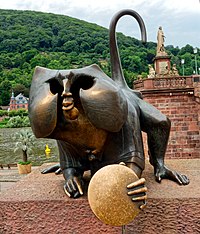Heidelberg bridge monkey
The history of the Heidelberg bridge monkey goes back to the 15th century (1481). A monkey was already sitting in the tower of the bridge at that time. A plastic stone figure with the bridge tower was destroyed in the Palatinate War of Succession .

The story of the Heidelberg bridge monkey
A monkey was already sitting in the tower of the bridge at that time in the 15th century. Located on the opposite side of the old town, the tower should arouse fear and respect for every newcomer. The monkey, on the other hand, was primarily intended for ridicule. With the grip on his bare rear he showed everyone passing by the "Kurpfälzischer Greeting". His backside was directed towards Kurmainz and therefore this greeting was especially addressed to the Mainz bishops. So the Heidelbergers made it clear that from this point on, the power of the elector was in effect and not that of the Mainz bishops. With the mirror in hand, he should invite everyone who passed him to critically reflect on himself.
Next to the monkey is still the poem by Martin Zeiller (1589–1661), which was written next to the statue as early as the 17th century:
"What are you doing at me here? Have you not seen the old monkey at Heydelberg / Go back and forth / You will find more of my like. "
The bronze statue
At the request of the Alt Heidelberg Association, Gernot Rumpf designed a bronze bridge monkey in 1977, which was ceremoniously erected in 1979. This bridge monkey is still on the old bridge next to the bridge tower ( 49 ° 24 ′ 47.88 ″ N , 8 ° 42 ′ 34.2 ″ E ). In contrast to its predecessors, today's monkey does not touch its rear end with its right hand, but rather shows the mano cornuta (Italian for 'horned hand'), which means averting the “evil eye” . The head of the statue is hollow and therefore a popular destination for many tourists to be photographed as a Heidelberg bridge monkey.
If you stroke the outstretched little finger and index finger of the right hand, it means that you are coming back to Heidelberg. If you stroke the mirror, you will find prosperity and if you touch the mice next to the monkey, many children are predicted.
The plush monkey
The Heidelberg (plush) bridge monkey has been available in stores since May 2016. It is available in 2 different sizes (approx. 15 cm and approx. 20 cm) in several shops in the old town of Heidelberg. It is a coveted souvenir of Heidelberg, especially among children . Unlike its predecessors, the Heidelberg (plush) bridge monkey neither touches its rear end nor shows the mano cornuta (Italian for 'horned hand'). These gestures are rather unsuitable for children's toys, which is why they opted for a friendly monkey with a mouthful. A coat of arms can be seen on the chest of the monkey, half of which consists of the coat of arms of the Electoral Palatinate ( Palatinate lion and white-blue diamonds of the Wittelsbacher ) and the other half of the flag of Germany and the Baden state coat of arms . Above it is the word "HEIDELBERG".
More bridge monkeys
The Heidelberg bridge monkey is not an isolated phenomenon. So z. B. in the 15th century two more bridge monkeys in Wertheim at the Kilian's chapel and in Denmark at the choir stalls in the cathedral of Ribe. These two bridge monkeys also have a mirror in their hand and, like the Heidelberg bridge monkey, are based on the genus of the vervet monkey .
Web links
Individual evidence
- ↑ The bridge monkey. Retrieved June 14, 2016 .
- ↑ Old Bridge. Retrieved June 14, 2016 .
- ↑ Old Bridge. Retrieved June 14, 2016 .
- ↑ Wilm Weber :: The Heidelberg bridge monkey is not an isolated phenomenon. In: Helmut Prückner (Ed.): The old bridge in Heidelberg. Ed .: Braus. Heidelberg 1988, p. 30-33 .


